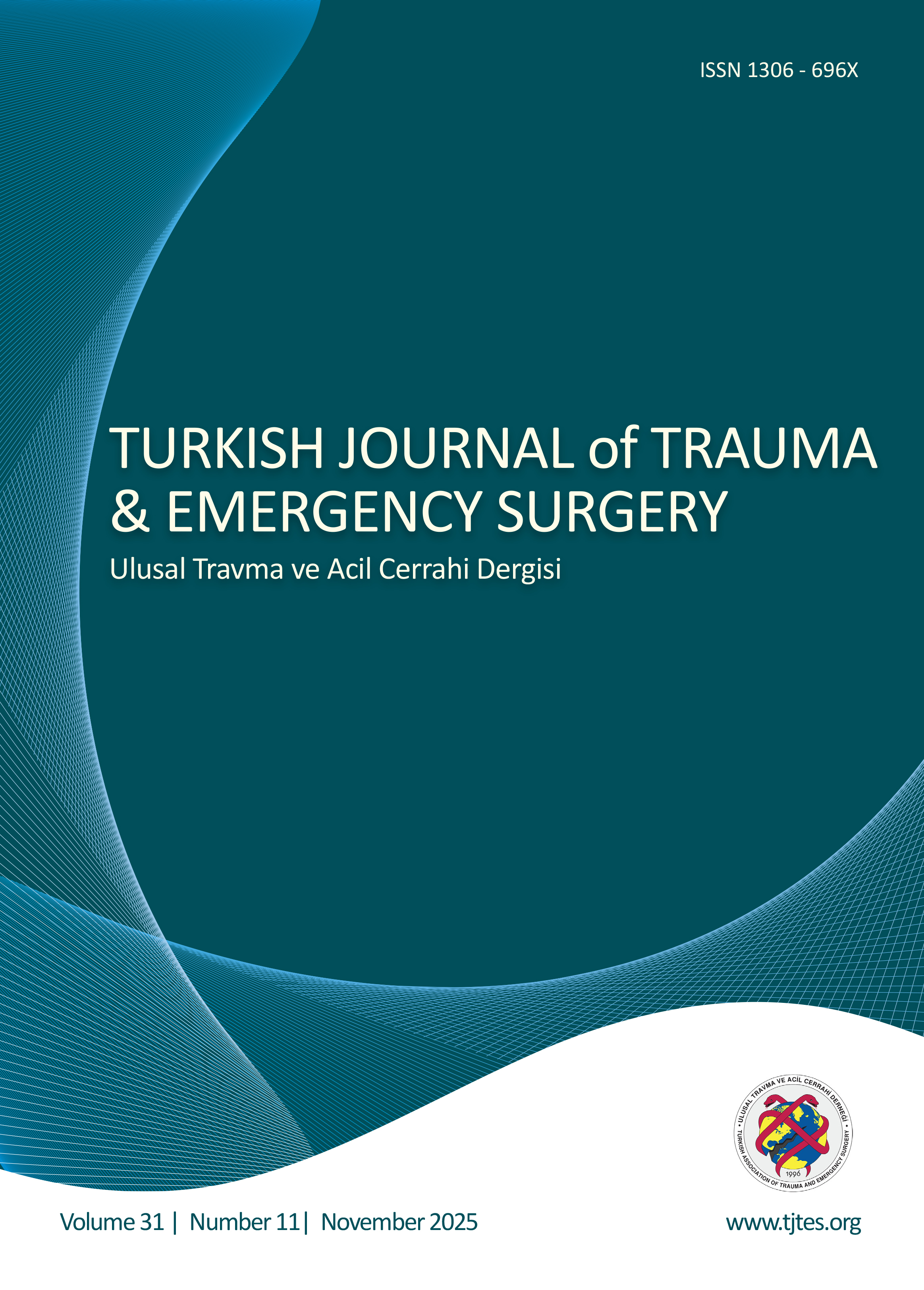Quick Search
Impact of the 1,2,3 triazole compound derived from salicylaldehyde on localized and systemic organ injury in an experimental superior mesenteric artery ischemia/reperfusion model
Uğur Kesici1, Sevgi KESICI2, Ayse TAN3, Yahya Kaan Karatepe4, Cumaali DEMİRTAŞ5, Kubra Bozali5, Mehmet Güray Duman6, Tamer İmamoğlu7, Eray Metin Guler6, Mert Somay1, Sezen Koyuncu1, Zeynep Bilge Yavuz1, Ahmet Furkan Mazlum8, Ali Durmus91University Of Health Sciences, Prof. Dr. Cemil Tascioglu, Training And Research Hospital, Department Of General Surgery, Istanbul, Turkey2University Of Health Sciences, Hamidiye Etfal, Training And Research Hospital, Department Of Anesthesiology And Reanimation, Istanbul, Türkiye
3Mus Alpaslan University, Technical Sciences Vocational School, Mus, Türkiye
4Battalgazi State Hospital, Department Of General Surgery, Malatya, Türkiye
5University Of Health Sciences, Hamidiye Health Sciences Institute, Department Of Physiology, Istanbul, Turkiye
6University Of Health Sciences, Haydarpasa Numune, Training And Research Hospital, Department Of Medical Biochemistry, Istanbul, Türkiye
7Beykent University, Medical Faculty, Department Of Pathology, Istanbul, Türkiye
8Karadeniz Eregli State Hospital, Department Of General Surgery, Karabük, Türkiye
9Private Avrasya Hospital, Department Of General Surgery, Istanbul, Türkiye
Background: Despite several studies indicating the efficacy of different molecules in preventing ischemia/reperfusion (I/R) damage, the most effective treatment remains unknown.
Methods: This study used 28 male Sprague rats. Rats were divided into four equal groups, with seven rats in each group. Groups; Group S (Sham), Group C (Control), Group E (Ethanol), Group T (Triazole). The superior mesenteric arteries of rats in all groups except Group S were exposed and closed with a vascular clamp, and ischemia was created for 1 hour. Oxidative stress parameters, ischemia markers, and biochemical tests showing organ functions were examined.
Results: The average Total antioxidant status (TAS) value of Group T was significantly higher compared to Group C and E while being significantly lower relative to Group S (p=0.001). The average Total oxidant status (TOS) value of Group T was significantly lower than that of Groups C and E and much higher than that of Group S (p<0.001). Despite the average oxidative stress index (OSI) value of Group T being markedly lower than that of Groups C and E, no statistically significant difference was observed in Group S (respectively; p=0.002, p<0.001, p=0.721). The average ischemia-modified albumin (IMA) value of Group T was significantly lower than that of Groups C and E and significantly higher than that of Group S (p<0.001). The mean malondialdehyde (MDA) value of Group T was significantly lower than that of Groups C and E and much higher than that of Group S (p<0.001).
Conclusion: This study represents the first investigation into the effect of a 1,2,3 triazole compound derived from salicylaldehyde on ischemia/reperfusion injury. The findings of this study provide strong evidence that the 1,2,3 triazole compound significantly enhances the prevention or treatment of experimental I/R injury. We argue that the triazole derivative may represent a viable therapeutic option for the treatment and prevention of I/R injury, supported by extensive experimental and clinical research. The triazole is expected to have enhanced protective properties, especially when solubilized by alternative methods.
Deneysel superior mezenterik arter iskemi/reperfüzyon modelinde salisilaldehitten türetilmiş 1,2,3 triazol bileşiğinin lokalize ve sistemik organ hasarı üzerindeki etkisi
Uğur Kesici1, Sevgi KESICI2, Ayse TAN3, Yahya Kaan Karatepe4, Cumaali DEMİRTAŞ5, Kubra Bozali5, Mehmet Güray Duman6, Tamer İmamoğlu7, Eray Metin Guler6, Mert Somay1, Sezen Koyuncu1, Zeynep Bilge Yavuz1, Ahmet Furkan Mazlum8, Ali Durmus91Sağlık Bilimleri Üniversitesi, Prof. Dr. Cemil Taşcıoğlu Şehir Hastanesi, Genel Cerrahi Kliniği, İstanbul, Türkiye2Sağlık Bilimleri Üniversitesi, Hamidiye Etfal Eğitim Ve Araştırma Hastanesi, Anesteziyoloji Ve Reanimasyon Kliniği, Istanbul, Türkiye
3Muş Alparslan Üniversitesi, Teknik Bilimler Meslek Yüksekokulu, Muş, Türkiye
4Battalgazi Devlet Hastanesi, Genel Cerrahi Kliniği, Malatya, Türkiye
5Sağlık Bilimleri Üniversitesi, Hamidiye Sağlık Bilimleri Enstitüsü, Fizyoloji Anabilim Dalı, İstanbul, Türkiye
6Sağlık Bilimleri Üniversitesi, Haydarpaşa Numune Eğitim Ve Araştırma Hastanesi, Tıbbi Biyokimya Anabilim Dalı, İstanbul, Türkiye
7Beykent Üniversitesi, Tıp Fakültesi, Patoloji Anabilim Dalı, İstanbul, Türkiye
8Karadeniz Ereğli Devlet Hastanesi, Genel Cerrahi Kliniği, Karabük, Türkiye
9Private Avrasya Hospital, Department Of General Surgery, Istanbul, Türkiye
Amaç: Farklı moleküllerin iskemi/reperfüzyon (I/R) hasarını önlemede etkili olduğunu gösteren birçok çalışmaya rağmen, en etkili tedavi yöntemi henüz bilinmemektedir.
Yöntemler: Bu çalışmada 28 erkek Sprague sıçanı kullanılmıştır. Sıçanlar, her grupta yedi sıçan olacak şekilde dört eşit gruba ayrılmıştır. Gruplar; Grup S (Sham), Grup C (Kontrol), Grup E (Etanol), Grup T (Triazol). Grup S hariç tüm gruplardaki sıçanların superior mezenterik arterleri açığa çıkarılıp vasküler klemp ile kapatılmış ve 1 saat boyunca iskemi oluşturulmuştur. Oksidatif stres parametreleri, iskemi belirteçleri ve organ fonksiyonlarını gösteren biyokimyasal testler incelenmiştir.
Bulgular: Grup T ortalama Total antioksidan seviye (TAS) değeri Grup C ve Eye göre istatiksel olarak anlamlı düzeyde yüksek, Grup Sye göre anlamlı düzeyde düşük tespit edildi (p=0.001). Grup T ortalama Total oksidan seviye (TOS) değeri Grup C ve Eye göre istatiksel olarak anlamlı düzeyde düşük, Grup Sye göre anlamlı düzeyde yüksek tespit edildi (p<0.001). Grup T ortalama Oksidatif stres indeksi (OSI) değeri Grup C ve Eye göre istatiksel olarak anlamlı düzeyde düşük, Grup Sye göre yüksek olmasına rağmen istatiksel olarak anlamlı fark tespit edilmedi (Sırasıyla; p=0.002, p<0.001, p=0.721). Grup T ortalama skemi modifiye albümin (İMA) değeri Grup C ve Eye göre istatiksel olarak anlamlı düzeyde düşük, Grup Sye göre anlamlı düzeyde yüksek tespit edildi (p<0.001). Grup T ortalama Malendialdehit (MDA) değeri Grup C ve Eye göre istatiksel olarak anlamlı düzeyde düşük, Grup Sye göre anlamlı düzeyde yüksek tespit edildi (p<0.001).
Sonuç: Bu çalışma, salisilaldehitten türetilmiş 1,2,3-triazol bileşiğinin iskemi/reperfüzyon hasarı üzerindeki etkisine ilişkin ilk araştırmayı temsil etmektedir. Bu çalışmanın bulguları, 1,2,3-triazol bileşiğinin deneysel İ/R hasarının önlenmesini veya tedavisini önemli ölçüde artırdığına dair güçlü kanıtlar sunmaktadır. Kapsamlı deneysel ve klinik araştırmalarla desteklenen triazol türevinin İ/R hasarının tedavisi ve önlenmesi için uygulanabilir bir tedavi seçeneği sunabileceğini savunuyoruz. Triazolün, özellikle alternatif yöntemlerle çözündürüldüğünde gelişmiş koruyucu özelliklere sahip olması beklenmektedir.
Manuscript Language: English




